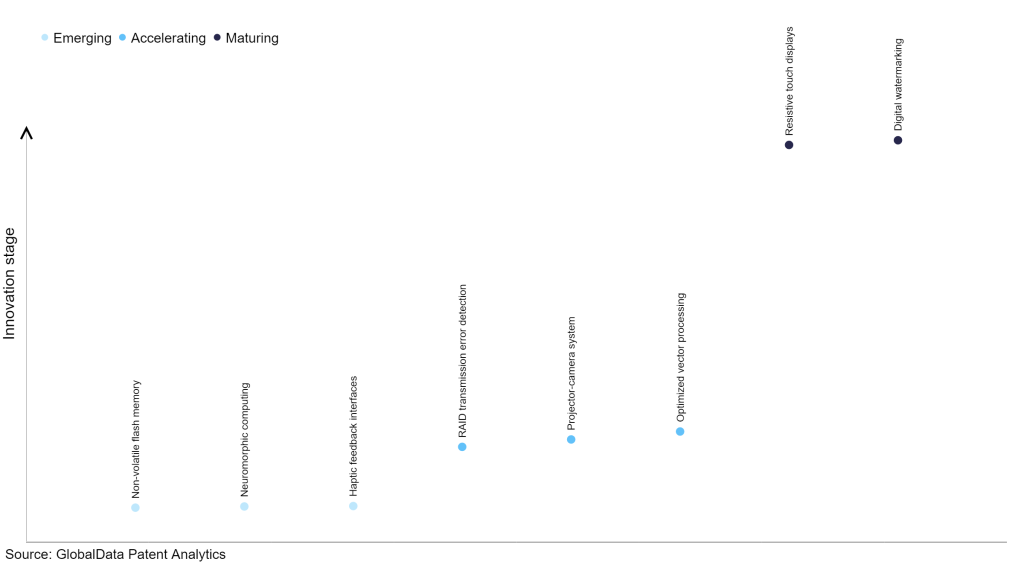The technology industry continues to be a hotbed of patent innovation. Activity is driven by the increasing automation in industries, the need for improved safety and efficiency in operations, and advancements in wireless communication technologies, and growing importance of technologies such as radio transmitters, receivers, antennas, and communication protocols. These technologies enable reliable and secure wireless communication between the control unit and the controlled devices. In the last three years alone, there have been over 1.5 million patents filed and granted in the technology industry, according to GlobalData’s report on Innovation in technology: radio-remote control. Buy the report here.
However, not all innovations are equal and nor do they follow a constant upward trend. Instead, their evolution takes the form of an S-shaped curve that reflects their typical lifecycle from early emergence to accelerating adoption, before finally stabilizing and reaching maturity.
Identifying where a particular innovation is on this journey, especially those that are in the emerging and accelerating stages, is essential for understanding their current level of adoption and the likely future trajectory and impact they will have.
185+ innovations will shape the technology industry
According to GlobalData’s Technology Foresights, which plots the S-curve for the technology industry using innovation intensity models built on over 1.6 million patents, there are 185+ innovation areas that will shape the future of the industry.
Within the emerging innovation stage, non-volatile flash memory, neuromorphic computing, and haptic feedback interfaces are disruptive technologies that are in the early stages of application and should be tracked closely. RAID transmission error detection, projector-camera system, and optimized vector processing are some of the accelerating innovation areas, where adoption has been steadily increasing. Among maturing innovation areas are resistive touch displays and digital watermarking, which are now well established in the industry.
Innovation S-curve for the technology industry

Radio-remote control is a key innovation area in technology
Radio-remote control is a technology that enables users to remotely operate devices using radio signals, providing convenience and flexibility. It is widely applied in various domains, including operating garage doors, controlling model airplanes and boats, and powering remote-controlled toys, enhancing user experience and enabling remote device control from a distance.
GlobalData’s analysis also uncovers the companies at the forefront of each innovation area and assesses the potential reach and impact of their patenting activity across different applications and geographies. According to GlobalData, there are 745+ companies, spanning technology vendors, established technology companies, and up-and-coming start-ups engaged in the development and application of radio-remote control.
Key players in radio-remote control – a disruptive innovation in the technology industry
‘Application diversity’ measures the number of applications identified for each patent. It broadly splits companies into either ‘niche’ or ‘diversified’ innovators.
‘Geographic reach’ refers to the number of countries each patent is registered in. It reflects the breadth of geographic application intended, ranging from ‘global’ to ‘local’.
Patent volumes related to radio-remote control
Source: GlobalData Patent Analytics
Samsung Group is the top patent filer in the radio-remote control space, followed by East West Manufacturing and Panasonic. Other leading patent filers in the space include LG and Sony Group.
By geographic reach, Adeia leads the pack, followed by Oakridge International and Baxter International. In terms of application diversity, Samsung Group holds the top position, followed by East West Manufacturing and Crown Equipment.
Radio-remote control provides users with the flexibility to control various devices from a distance, offering convenience, safety, and enhanced user experience. Radio-remote control technology has found widespread applications in areas such as home automation, industrial operations, entertainment, and transportation, empowering users to operate devices effortlessly and efficiently.
To further understand the key themes and technologies disrupting the technology industry, access GlobalData’s latest thematic research report on Technology.
Data Insights
From

The gold standard of business intelligence.
Blending expert knowledge with cutting-edge technology, GlobalData’s unrivalled proprietary data will enable you to decode what’s happening in your market. You can make better informed decisions and gain a future-proof advantage over your competitors.







